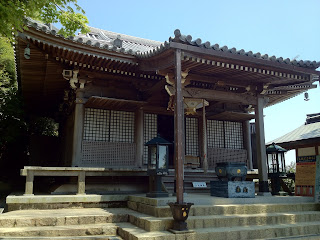The shrine is most famous for the torii (gate) that appears to float above the water. More on this later...
The island is home to several deer which have become accustomed to humans. They won't bother you and usually you can pet them, though you probably shouldn't. They expect handouts of food, none of which is good for them.
As you approach the shrine from the ferry dock, you see plenty of shops selling food, omiyage (souvenir gifts), and other goods.
You then continue through a covered area with even more shops. When you decide to go shopping, I recommend checking prices and taking notes. Most stores have the same or similar prices but values can be found.
The area is known for its rice spoons, and the world's largest is freely visible in the shopping arcade. Be sure to get a picture of your family standing next to it - everybody else was.
This is one of Japan's three best views. Unfortunately, a typhoon came through about a month prior to my visit and the torii gate was covered in scaffolding to be repaired and stabilized. The torii sits on the bed of the Seto Inland Sea, so typhoons and earthquakes can cause damage.
I visited during Golden Week, so despite the scaffolding the place was pretty crowded in the morning. This is the queue leading into Itsukushima Shrine itself.
The shrine is built over the water. The island is considered holy land and was off-limits to normal people for centuries. To allow commoners to visit and pray, the torii was placed in the water and the shrine was built off-shore. Of course, now people can explore the entire island.
I didn't go in the shrine because it was so busy. I'll have to make a return trip at some point to see the torii gate without scaffolding. However, I could see bits and pieces of it from outside the gates.
On a hill overlooking the shrine is this, the Gojunoto (five storied pagoda). I didn't make it up this hill, where more shrines and temples can be found. I instead explored the other side of the island and Mount Misen.
But first, another view of the shrine.
Manju is a popular Japanese sweet with a flour, rice, and buckwheat-based covering and red bean paste inside. It's similar to mochi, and is cooked to brown the outside. Miyajima is famous for momiji (Japanese maple) manju, which is put into molds similar to waffle irons so the sweets take the shape of maple leaves.
This is a fresh momiji manju. It was still warm from being cooked - you can't buy momiji manju as fresh as this anywhere else! The red bean paste filling is pretty sweet but there are other flavors to appeal to international tourists. I later tried some of the others - chocolate was really good too. Remember the deer? They know what the packaging sounds like being opened and about a dozen deer started walking toward me when I opened the package to get the picture and enjoy my treat. Be aware - they like manju! Don't worry, they didn't get any.
Okay, it's time to take a hike. I followed this path toward the ropeway, which continues on to head up the mountain. If you're climbing Mount Misen, be prepared with plenty of water. There were a couple small shops selling drinks before the ropeway, but nothing else was available until you reached the top - where there are expensive vending machines. And you could pack a lunch to eat at the top.
I crossed a nice bridge near the bottom.
This looks promising.
You follow the stream for a little while, but once the real climbing begins, you're on your own.
There are lots of steps on this trail. It's a very steep climb, but it is shaded most of the way.
Yes, it's a 2.5 km hike. And it isn't easy.
Ahh, finally, I've reached the top. Kind of. This is a nice view, though!
There are several levels of "top" starting with an area holding a couple shrines.
This shrine was the most popular, and I believe it is the Misen Hondo Main Hall.
That would probably make this the Reikado Hall.
The top of the mountain has lots of little neat areas to look at or in. I'm sure they all have some religious importance, though, so respect is important.
Am I at the top of the top? Not quite. But close. Most people take the ropeway, so I didn't realize how crowded the top would be until I got there.
But again, the views are great. Hiroshima is off in the distance. At the top of the top, there's a viewing platform and another shop/vending machine.
I then walked back across to the ropeway entrance to take the easy way down. It was getting late and I was exhausted. The view from the ropeway building back to the top of Mount Misen is seen above.
And this is the "summit" station. It is a bit of a walk from the top of Mount Misen to the ropeway station.
But views here are pretty nice too.
Back at the bottom, I headed toward Daisho-in Temple, which might be the coolest temple I'll visit in Japan. It is one of the most important temples of Shingon Buddhism. On the way over I saw a couple snakes. Here's one slithering in the brush just off the trail/
Here's the other, crossing the track. Signs were plentiful warning visitors to be on the lookout for snakes. There are poisonous vipers on the island, but these guys were probably harmless. Nevertheless, I kept my distance.
I'll take you to Daisho-in Temple and the rest of my trip tomorrow!
















































































